An Experimental Investigation of the Effects of Block Proportion on Bimrocks, Considering Different Block-to-Matrix Strength Ratios
Abstract
1. Introduction
2. Materials and Methods
2.1. Obtaining Blocks and Sample Preparation
2.2. Equipment and Tests
3. Results and Analysis
3.1. Uniaxial Compression Strength and Failure Characteristics
3.2. Shear Strength and Behavior
3.3. Cohesion and Internal Friction Angle
4. Discussion
5. Conclusions
- (1)
- The stress–strain curve of the weak matrix sample decreases slowly after reaching the peak value. With the increase in VBP, this phenomenon is more obvious. The curve of the strong matrix sample will drop sharply after reaching its peak strength. The VBP is negatively correlated with the peak stress and peak strain of the sample.
- (2)
- With the increase in VBP, the UCS of the strong matrix samples decreases gradually, and the UCS of the weak matrix samples shows an increasing trend as a whole. However, when the VBP is larger than 60%, the strength is lower. The crack opening of weak matrix samples is obviously larger than that of strong matrix samples. With the increase in VBP, the crack distribution of weak matrix samples gradually changes from an inclined distribution to a vertical distribution, while the crack distribution of strong matrix samples is just the opposite.
- (3)
- In the weak matrix sample, the shear strength of the sample decreases with the increase in VBP under various normal stress ranges. However, the influence of VBP in the strong matrix sample is more chaotic. With the increase in normal stress, the failure cracks of weak matrix specimens tend to tilt in the vertical direction, while the secondary cracks extending to the top (or bottom) surface appear in the strong matrix specimens. With the increase in VBP, the shear band of weak matrix specimens increases obviously, while multiple secondary cracks appear in the strong matrix specimens.
- (4)
- The effect of the VBP on cohesion and internal friction angle is less related to the block-to-matrix strength ratio. The internal friction angle shows a slight increasing trend, while the cohesion shows a decreasing trend. The variation of internal friction angle and cohesion of strong matrix samples is relatively large when the VBP is small.
Author Contributions
Funding
Institutional Review Board Statement
Informed Consent Statement
Data Availability Statement
Acknowledgments
Conflicts of Interest
References
- Medley, E.W.; Zekkos, D. Geopractitioner Approaches to Working with Antisocial Mélanges. In Mélanges: Processes of Formation and Societal Significance; Geological Society of America: Boulder, CO, USA, 2011; ISBN 978-0-8137-2480-5. [Google Scholar]
- Napoli, M.L.; Barbero, M.; Scavia, C. Effects of Block Shape and Inclination on the Stability of Melange Bimrocks. Bull. Eng. Geol. Environ. 2021, 80, 7457–7466. [Google Scholar] [CrossRef]
- Kahraman, S.; Alber, M.; Fener, M.; Gunaydin, O. Evaluating the Geomechanical Properties of Misis Fault Breccia (Turkey). Int. J. Rock Mech. Min. Sci. 2008, 45, 1469–1479. [Google Scholar] [CrossRef]
- Alber, M.; Kahraman, S. Predicting the Uniaxial Compressive Strength and Elastic Modulus of a Fault Breccia from Texture Coefficient. Rock Mech. Rock Eng. 2009, 42, 117–127. [Google Scholar] [CrossRef]
- Hu, X.; Chen, M.; Liu, H.; Zhou, B.; Lu, Y. Experimental Study on Effect of Rock Block Content on Mechanical Properties of Conglomerate. In Proceedings of the 55th U.S. Rock Mechanics/Geomechanics Symposium, Virtual, 18–25 June 2021. [Google Scholar]
- Migoń, P.; Duszyński, F. Landscapes and Landforms in Coarse Clastic Sedimentary Tablelands—Is There a Unifying Theme? CATENA 2022, 218, 106545. [Google Scholar] [CrossRef]
- Napoli, M.L.; Milan, L.; Barbero, M.; Scavia, C. Identifying Uncertainty in Estimates of Bimrocks Volumetric Proportions from 2D Measurements. Eng. Geol. 2020, 278, 105831. [Google Scholar] [CrossRef]
- Afifipour, M.; Moarefvand, P. Mechanical Behavior of Bimrocks Having High Rock Block Proportion. Int. J. Rock Mech. Min. Sci. 2014, 65, 40–48. [Google Scholar] [CrossRef]
- Mahdevari, S.; Maarefvand, P. An Investigation into the Effects of Block Size Distribution Function on the Strength of Bimrocks Based on Large-Scale Laboratory Tests. Arab. J. Geosci. 2016, 9, 509. [Google Scholar] [CrossRef]
- Avşar, E. An Experimental Investigation of Shear Strength Behavior of a Welded Bimrock by Meso-Scale Direct Shear Tests. Eng. Geol. 2021, 294, 106321. [Google Scholar] [CrossRef]
- Wei, D.; Wang, J.; Zhao, B. A Simple Method for Particle Shape Generation with Spherical Harmonics. Powder Technol. 2018, 330, 284–291. [Google Scholar] [CrossRef]
- Sharafisafa, M.; Aliabadian, Z.; Shen, L. Crack Initiation and Failure Development in Bimrocks Using Digital Image Correlation under Dynamic Load. Theor. Appl. Fract. Mech. 2020, 109, 102688. [Google Scholar] [CrossRef]
- Hu, Y.; Sun, S.; Wei, J. Effect of Cementation Degree on Shear Characteristic and Failure Mechanism of Bimrocks Containing Gravels of Different Sizes. Lithosphere 2022, 2022, 1334579. [Google Scholar] [CrossRef]
- Mahdevari, S.; Moarefvand, P.; Mohammadzamani, D. Considering the Effect of Block-to-Matrix Strength Ratio on Geomechanical Parameters of Bimrocks. Geotech. Geol. Eng. 2020, 38, 4501–4520. [Google Scholar] [CrossRef]
- Zhu, G.; Ding, Y.; Cao, Y. The Effect of Block-Matrix Interface of SRM with High Volumetric Block Proportion on Its Uniaxial Compressive Strength. Appl. Sci. 2023, 13, 3463. [Google Scholar] [CrossRef]
- Mahdevari, S.; Maarefvand, P. Applying Ultrasonic Waves to Evaluate the Volumetric Block Proportion of Bimrocks. Arab. J. Geosci. 2017, 10, 204. [Google Scholar] [CrossRef]
- Napoli, M.L.; Milan, L.; Barbero, M.; Medley, E. Investigation of Virtual Bimrocks to Estimate 3D Volumetric Block Proportions from 1D Boring Measurements. Geosciences 2022, 12, 405. [Google Scholar] [CrossRef]
- Gao, W.; Hu, R.; Oyediran, I.A.; Li, Z.; Zhang, X. Geomechanical Characterization of Zhangmu Soil-Rock Mixture Deposit. Geotech. Geol. Eng. 2014, 32, 1329–1338. [Google Scholar] [CrossRef]
- Gao, W.; Iqbal, J.; Hu, R. Investigation of Geomechanical Characterization and Size Effect of Soil-Rock Mixture: A Case Study. Bull. Eng. Geol. Environ. 2021, 80, 6263–6274. [Google Scholar] [CrossRef]
- Li, K.; Sun, S.; Le, H.; Wei, J.; Hu, Y. Study on Uniaxial Compressive Strength of Double Matrix Bimrocks Considering Different Block Proportions. Bull. Eng. Geol. Environ. 2023, 82, 293. [Google Scholar] [CrossRef]
- Montoya-Araque, E.A.; Suarez-Burgoa, L.O.; Medley, E.W. Application of the Tortuous Surface Method to Stochastic Analysis of Bimslope Stability. Bull. Eng. Geol. Environ. 2020, 79, 5329–5340. [Google Scholar] [CrossRef]
- Lin, Y.; Peng, L.; Lei, M.; Wang, X.; Cao, C. Predicting the Mechanical Properties of Bimrocks with High Rock Block Proportions Based on Resonance Testing Technology and Damage Theory. Appl. Sci. 2019, 9, 3537. [Google Scholar] [CrossRef]
- Lin, Y.; Peng, L.; Lei, M.; Yang, W.; Liu, J. Mechanical Properties of Bimrocks with High Rock Block Proportion. J. Cent. South Univ. 2019, 26, 3397–3409. [Google Scholar] [CrossRef]
- Ding, Y.; Zhang, Q.; Zhao, S.; Chu, W.; Meng, Q. An Improved DEM-Based Mesoscale Modeling of Bimrocks with High-Volume Fraction. Comput. Geotech. 2023, 157, 105351. [Google Scholar] [CrossRef]
- Sonmez, H.; Gokceoglu, C.; Medley, E.W.; Tuncay, E.; Nefeslioglu, H.A. Estimating the Uniaxial Compressive Strength of a Volcanic Bimrock. Int. J. Rock Mech. Min. Sci. 2006, 43, 554–561. [Google Scholar] [CrossRef]
- Sonmez, H.; Ercanoglu, M.; Kalender, A.; Dagdelenler, G.; Tunusluoglu, C. Predicting Uniaxial Compressive Strength and Deformation Modulus of Volcanic Bimrock Considering Engineering Dimension. Int. J. Rock Mech. Min. Sci. 2016, 86, 91–103. [Google Scholar] [CrossRef]
- Kalender, A.; Sonmez, H.; Medley, E.; Tunusluoglu, C.; Kasapoglu, K.E. An Approach to Predicting the Overall Strengths of Unwelded Bimrocks and Bimsoils. Eng. Geol. 2014, 183, 65–79. [Google Scholar] [CrossRef]
- Kahraman, S.; Alber, M. Estimating Unconfined Compressive Strength and Elastic Modulus of a Fault Breccia Mixture of Weak Blocks and Strong Matrix. Int. J. Rock Mech. Min. Sci. 2006, 43, 1277–1287. [Google Scholar] [CrossRef]
- ASTM. Annual Book of ASTM Standards-Soil and Rock, Building Stones, Section-4, Construction; ASTM Publications: Philadelphia, PA, USA, 2014; Volume 08. [Google Scholar]
- Avşar, E. Contribution of Fractal Dimension Theory into the Uniaxial Compressive Strength Prediction of a Volcanic Welded Bimrock. Bull. Eng. Geol. Environ. 2020, 79, 3605–3619. [Google Scholar] [CrossRef]
- Sheikhpourkhani, A.; Bahaaddini, M.; Oh, J.; Masoumi, H. Numerical Study of the Mechanical Behaviour of Unwelded Block in Matrix Rocks under Direct Shearing. Bull. Eng. Geol. Environ. 2024, 83, 22. [Google Scholar] [CrossRef]
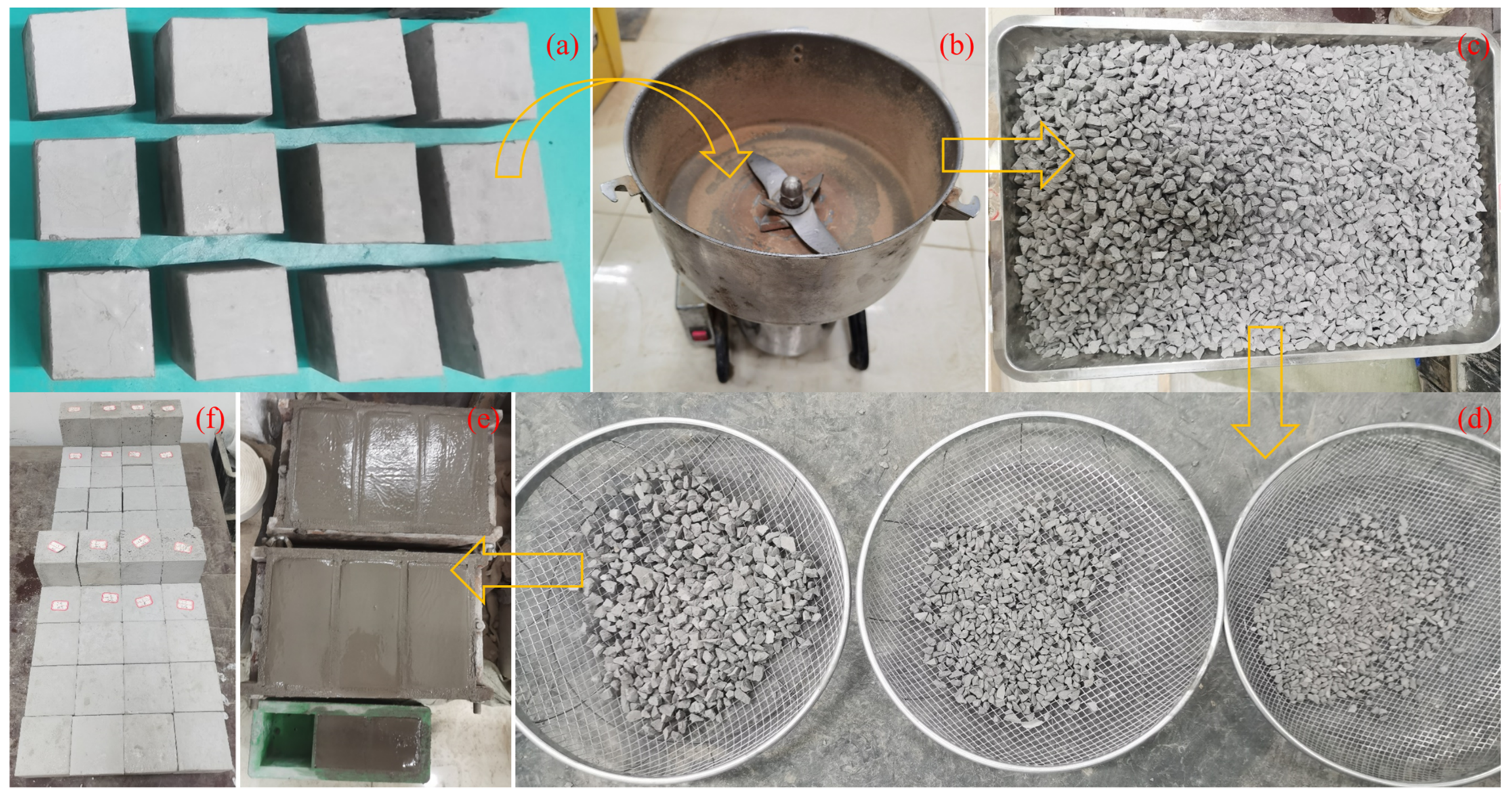
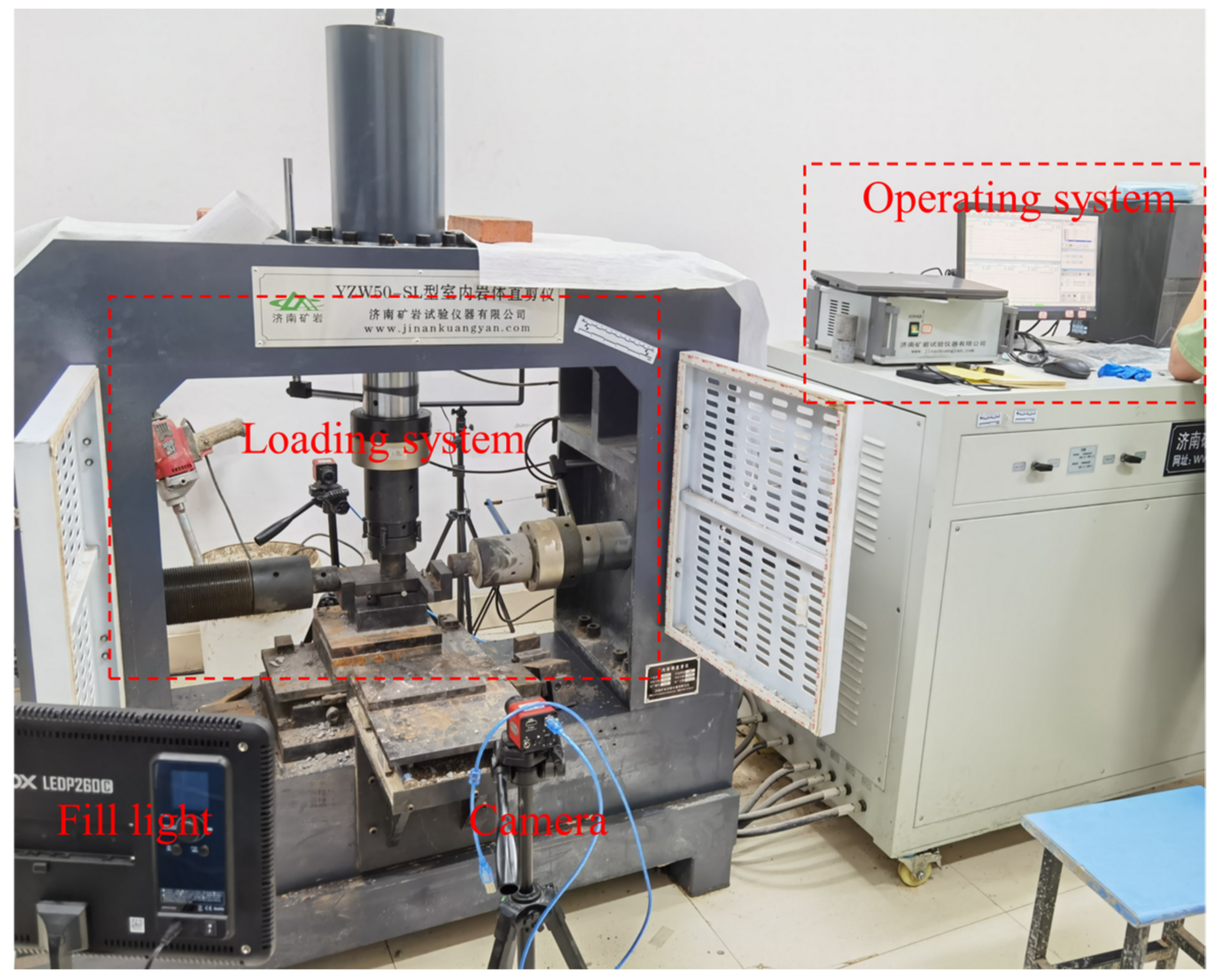

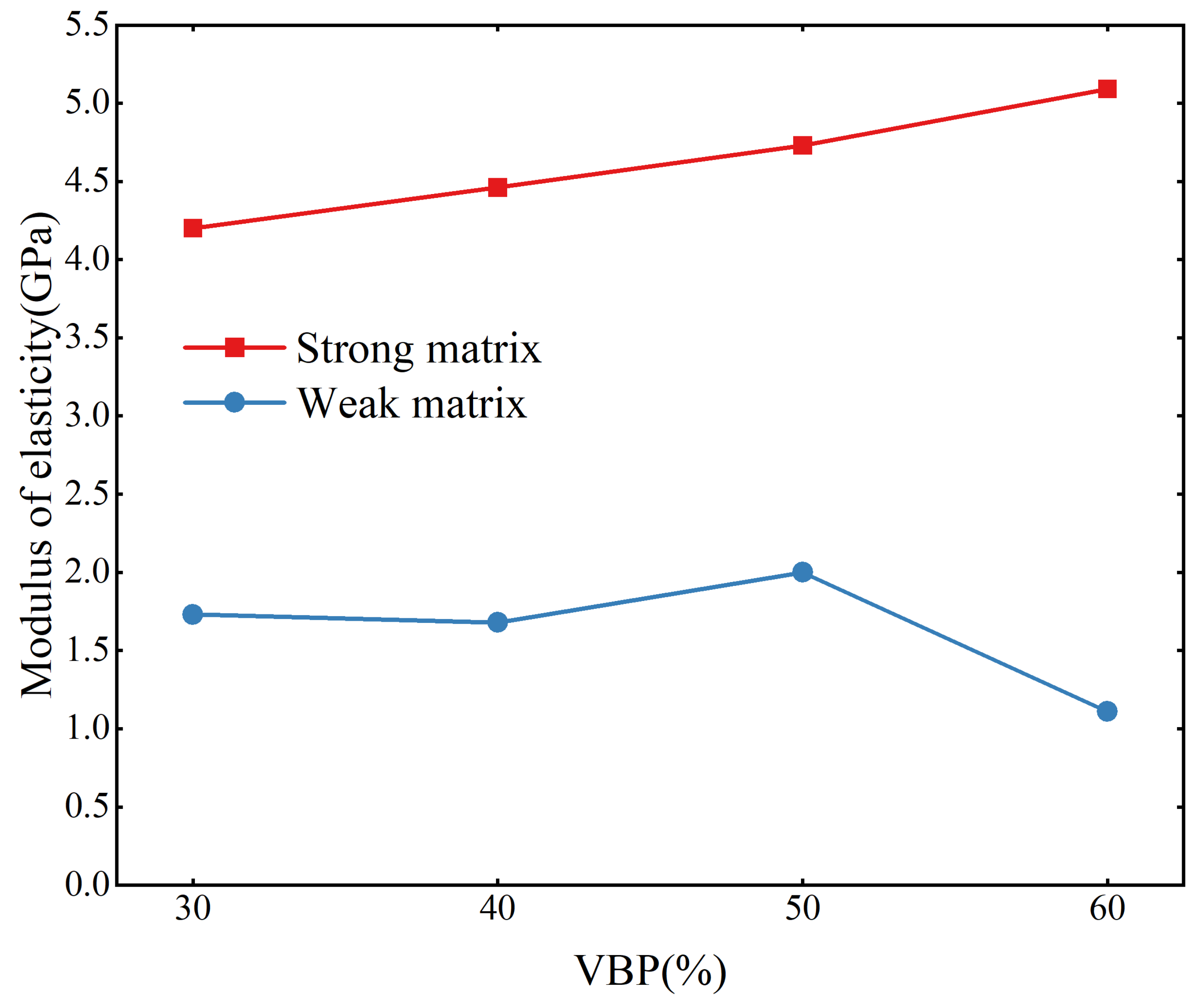
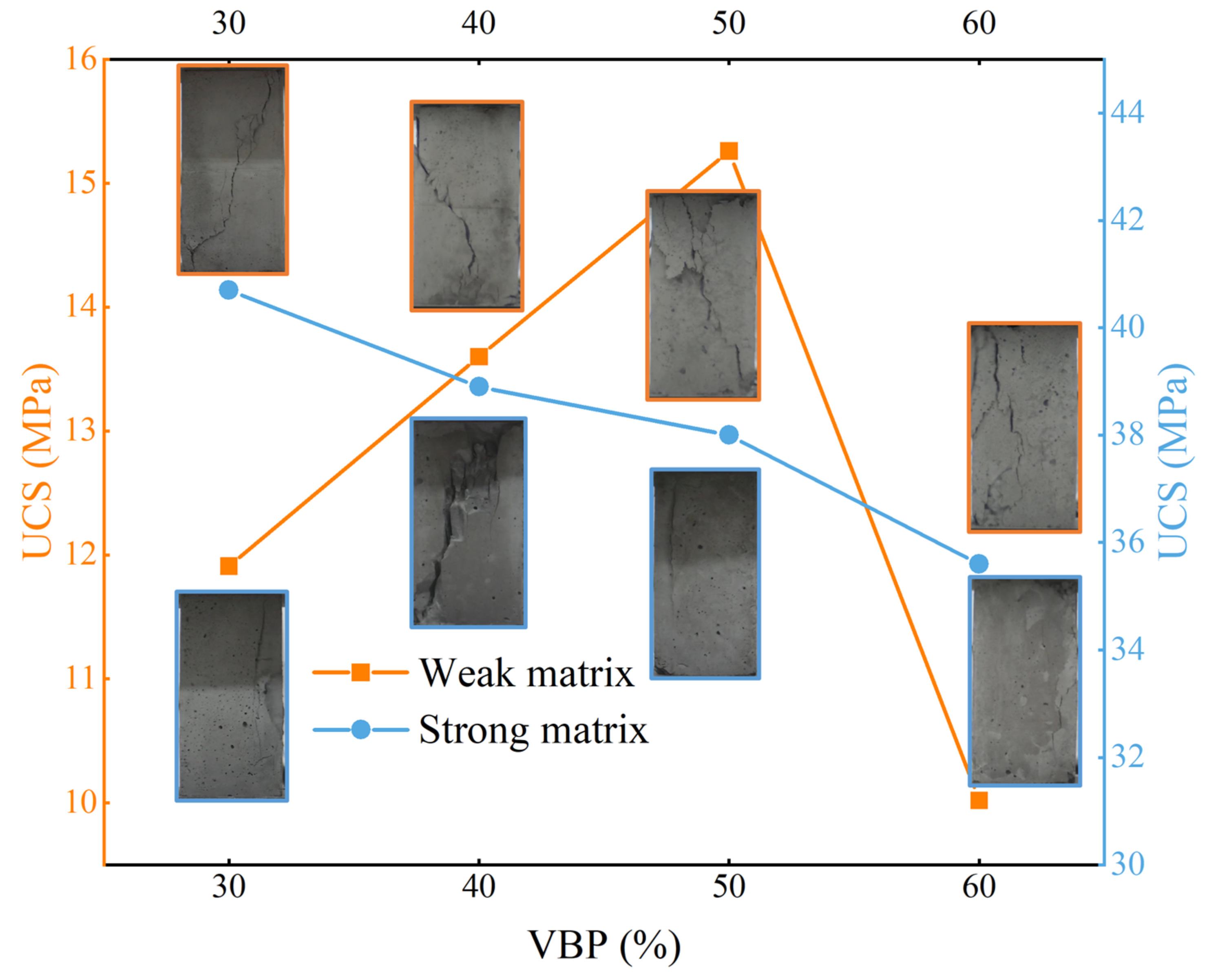
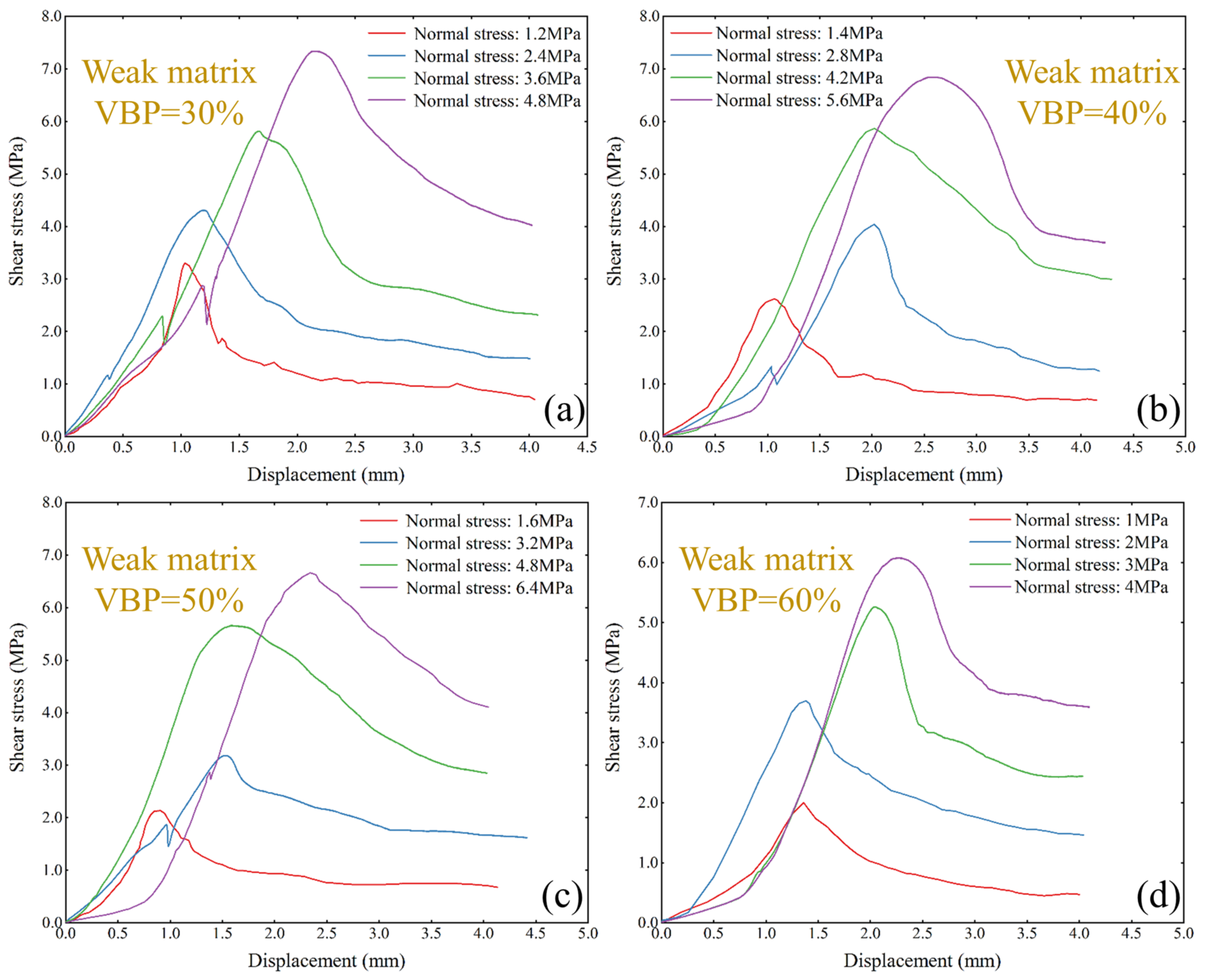
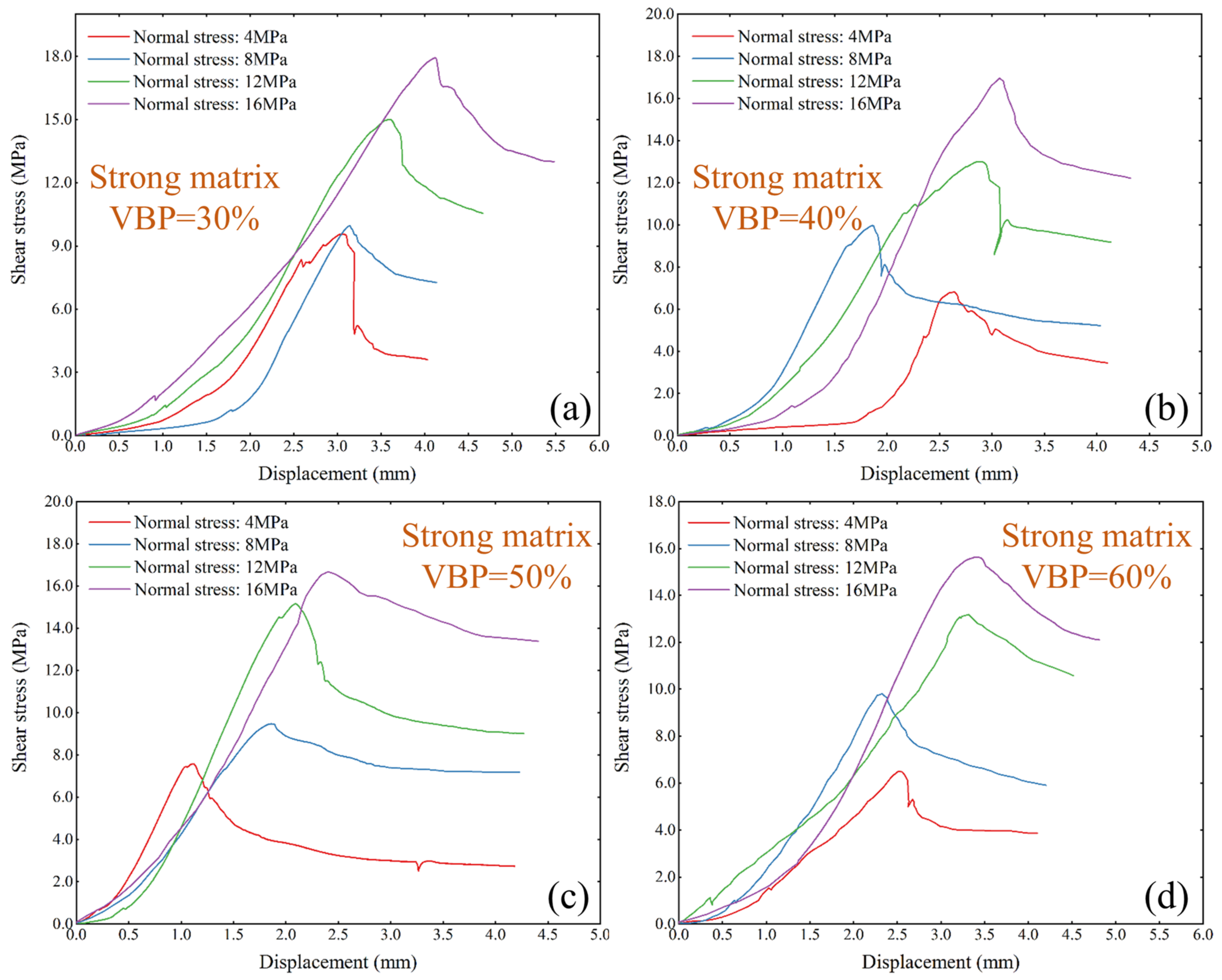



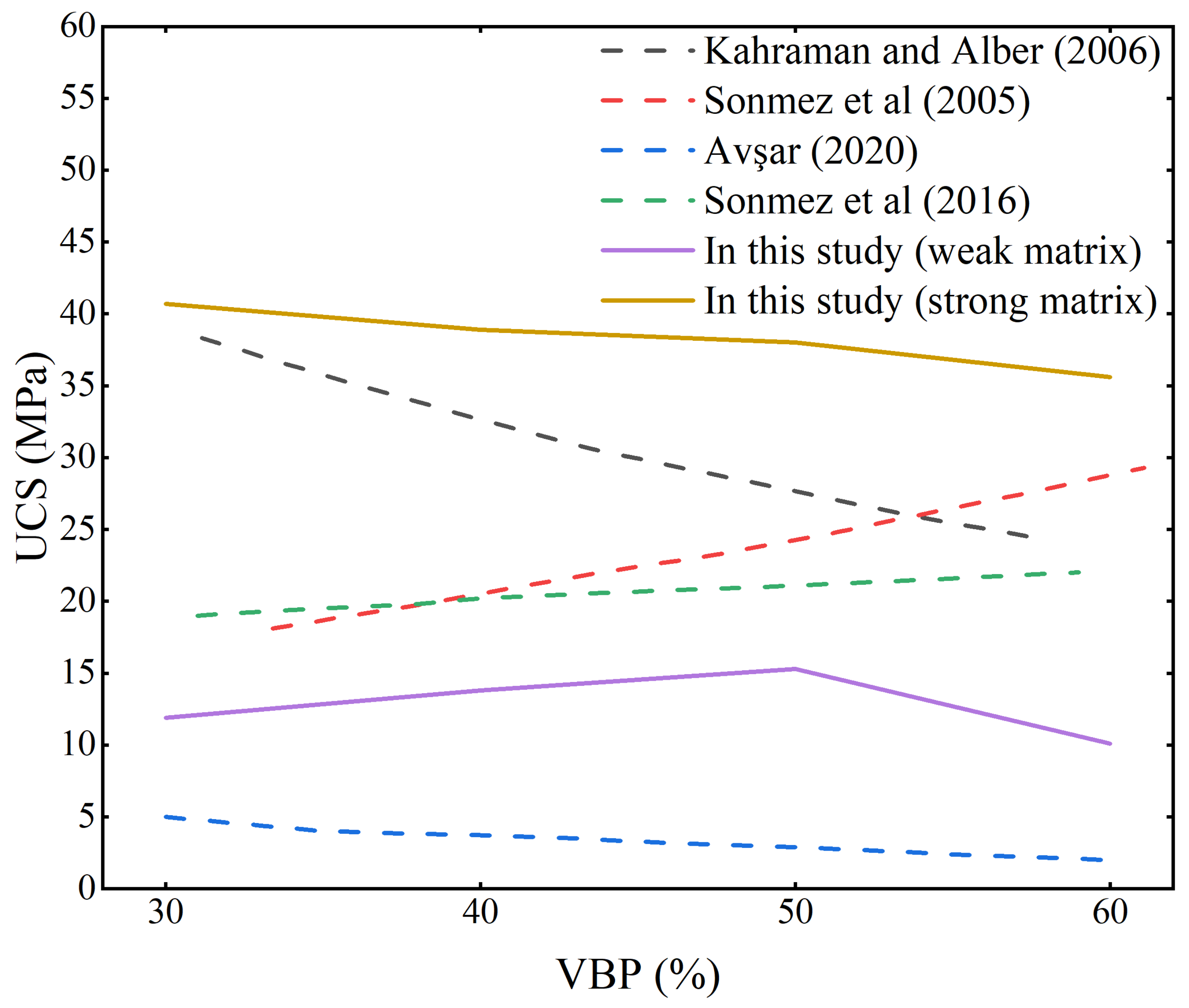
| UCS (MPa) | Shear Stress (MPa) | Cohesion (MPa) | Internal Friction Angle (°) | |
|---|---|---|---|---|
| Weak matrix | 14.2 | 8.2 | 3.4 | 44.3 |
| Strong matrix | 41.2 | 23.6 | 7.6 | 36.8 |
| Rock block | 32.7 | 18.7 | 5.9 | 38.5 |
Disclaimer/Publisher’s Note: The statements, opinions and data contained in all publications are solely those of the individual author(s) and contributor(s) and not of MDPI and/or the editor(s). MDPI and/or the editor(s) disclaim responsibility for any injury to people or property resulting from any ideas, methods, instructions or products referred to in the content. |
© 2024 by the authors. Licensee MDPI, Basel, Switzerland. This article is an open access article distributed under the terms and conditions of the Creative Commons Attribution (CC BY) license (https://creativecommons.org/licenses/by/4.0/).
Share and Cite
Hu, Y.; Sun, S.; Sun, Y.; Wei, J.; Le, H.; Li, K.; Zhao, B. An Experimental Investigation of the Effects of Block Proportion on Bimrocks, Considering Different Block-to-Matrix Strength Ratios. Materials 2024, 17, 1114. https://doi.org/10.3390/ma17051114
Hu Y, Sun S, Sun Y, Wei J, Le H, Li K, Zhao B. An Experimental Investigation of the Effects of Block Proportion on Bimrocks, Considering Different Block-to-Matrix Strength Ratios. Materials. 2024; 17(5):1114. https://doi.org/10.3390/ma17051114
Chicago/Turabian StyleHu, Yanran, Shaorui Sun, Yuyong Sun, Jihong Wei, Huilin Le, Kai Li, and Bohan Zhao. 2024. "An Experimental Investigation of the Effects of Block Proportion on Bimrocks, Considering Different Block-to-Matrix Strength Ratios" Materials 17, no. 5: 1114. https://doi.org/10.3390/ma17051114
APA StyleHu, Y., Sun, S., Sun, Y., Wei, J., Le, H., Li, K., & Zhao, B. (2024). An Experimental Investigation of the Effects of Block Proportion on Bimrocks, Considering Different Block-to-Matrix Strength Ratios. Materials, 17(5), 1114. https://doi.org/10.3390/ma17051114







